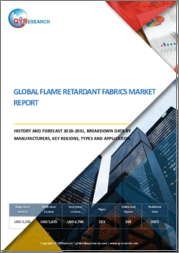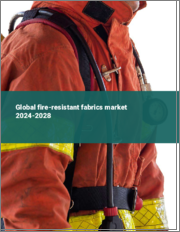
|
시장보고서
상품코드
1516047
세계의 섬유 난연제 시장 : 유형별, 재료별, 최종사용자별 - 예측(2024-2032년)Textile Flame Retardants Market - By Type (Halogenated Flame Retardants, Phosphorus-based Flame Retardants, Nitrogen-based Flame Retardants), By Material (Polyester, Cotton, Viscose, Nylon 6, Nylon 6, 6), By End User & Forecast, 2024 - 2032 |
||||||
세계의 섬유 난연제 시장 규모는 업계 전체의 안전성에 대한 관심 증가와 난연성 재료 사용을 의무화하는 엄격한 규제가 원동력이 되어 2024-2032년 CAGR 3.7%로 성장할 전망입니다.
건설 분야와 자동차 분야의 확장은 시장의 중요한 성장 동력이 되고 있습니다. 건설 부문은 2022년 전 세계에서 8조 2,000억 달러 규모로 확대되고 2029년까지 두 배로 증가할 것으로 예상(ToolSense)되기 때문에 난연성 소재에 대한 수요가 급증할 것으로 예상됩니다. 마찬가지로 자동차 산업의 성장도 섬유 난연제가 자동차 인테리어의 안전과 규제 기준 준수를 보장하기 위해 점점 더 중요해지고 있으므로 이러한 수요를 더욱 촉진하고 있습니다. 또한 인프라 개발 프로젝트 증가와 신흥 시장에서의 화재 안전 규제에 대한 중요성 증가는 섬유 난연제 시장의 확대에 기여하여 시장의 지속적인 성장을 가속하고 있습니다.
섬유 난연제 산업은 유형, 재료, 최종사용자 및 지역별로 분류됩니다.
질소계 난연제는 환경에 미치는 영향을 최소화하면서 우수한 난연성을 제공하기 때문에 질소계 난연제 부문은 2032년까지 급성장할 것으로 예상됩니다. 정부와 규제기관이 지속가능성과 환경 보호에 중점을 두면서 질소계 난연제에 대한 수요가 급증할 것으로 예상됩니다. 제조업체들은 이러한 난연제의 효과와 환경 적합성을 높이기 위해 연구개발 활동에 투자하고 있으며, 이는 시장의 기술 혁신을 촉진하고 있습니다. 친환경 제품의 중요성에 대한 소비자의 인식이 높아진 것도 이 부문의 성장에 기여하고 있습니다. 환경 친화적 인 소비자가 지속가능한 솔루션을 점점 더 우선시함에 따라 질소계 난연제로 처리된 섬유 제품에 대한 수요가 확대되어 시장 확장을 더욱 촉진할 것으로 예상됩니다.
면은 천연섬유이기 때문에 의류, 가정용 가구, 산업용 섬유 등 다양한 섬유 용도에 널리 사용되고 있습니다. 특히 화재 안전과 함께 편안함과 통기성이 필수적인 산업에서 난연성 면직물에 대한 수요가 증가하고 있습니다. 면 소재에 맞게 조정된 혁신적인 난연 기술은 최종사용자의 특정 요구 사항을 충족시키기 위해 개발되어이 부문의 성장을 주도하고 있습니다.
유럽의 섬유 난연제 산업은 2032년까지 양호한 속도로 성장할 것으로 예상됩니다. 유럽은 화재 안전에 대한 규제 프레임워크와 기준이 엄격하고, 건설, 운송, 제조 등 다양한 분야에서 난연성 섬유에 대한 수요가 증가하고 있기 때문입니다. 또한 인프라 구축 및 개보수 프로젝트에 대한 투자가 증가하고 있는 것도 이 지역의 난연성 소재 수요를 촉진하고 있습니다. 유명한 시장 기업의 존재와 기술 발전은 유럽 섬유 난연제 시장의 성장을 더욱 촉진하고 있습니다.
목차
제1장 조사 방법과 조사 범위
제2장 개요
제3장 업계 인사이트
- 에코시스템 분석
- 주요 제조업체
- 유통업체
- 업계 전체 이익률
- 업계에 대한 영향요인
- 촉진요인
- 시장이 해결해야 할 과제
- 시장 기회
- 원재료 상황
- 제조 동향
- 기술 진화
- 원재료의 지속가능성
- 원재료 가격 동향(달러/톤)
- 규제와 시장에 대한 영향
- 무역통계
- 미충족 요구
- Porter의 산업 분석
- PESTEL 분석
제4장 경쟁 구도
- 기업 점유율 분석
- 경쟁 포지셔닝 매트릭스
- 전략 전망 매트릭스
제5장 시장 규모·예측 : 유형별(2018-2032년)
- 주요 동향
- 할로겐계 난연제
- 인계 난연제
- 질소계 난연제
- 기타
제6장 시장 규모·예측 : 재료별(2018-2032년)
- 주요 동향
- 폴리에스테르
- 면
- 비스코스
- 나일론 6
- 나일론 6,6
- 기타
제7장 시장 규모·예측 : 최종사용자별(2018-2032년)
- 주요 동향 산업용
- 산업용
- 방위
- 공공안전 & 서비스
- 운송
- 가정
- 기타
제8장 시장 규모·예측 : 지역별(2018-2032년)
- 주요 동향
- 북미
- 미국
- 캐나다
- 유럽
- 독일
- 영국
- 프랑스
- 이탈리아
- 스페인
- 기타 유럽
- 아시아태평양
- 중국
- 인도
- 일본
- 한국
- 호주
- 기타 아시아태평양
- 라틴아메리카
- 브라질
- 멕시코
- 아르헨티나
- 기타 라틴아메리카
- 중동 및 아프리카
- 사우디아라비아
- 아랍에미리트
- 남아프리카공화국
- 기타 중동 및 아프리카
제9장 기업 개요
- Akzo Nobel N.V.
- Albemarle Corporation
- Archroma
- BASF SE
- Clariant AG
- DIC Corporation
- Dow Chemical Company
- Huntsman Corporation
- ICL Group
- Italmatch Chemicals
- Jiangsu Yoke Technology Co., Ltd.
- Lanxess AG
- Nouryon
- Sinochem Group
- Thor Group
Global Textile Flame Retardants Market size will grow at over 3.7 during 2024-2032, driven by increasing safety concerns across industries and stringent regulations mandating the use of flame-retardant materials.
The expansion of the construction and automotive sectors serves as a significant growth driver for the market. With the construction sector scaling to $8.2 trillion globally in 2022 and expected to double by 2029 (ToolSense), the demand for flame retardant materials is set to surge. Similarly, the automotive industry's growth further fuels this demand as flame retardant textiles become increasingly essential for ensuring safety and compliance with regulatory standards in vehicle interiors. Additionally, the rise in infrastructure development projects and the growing emphasis on fire safety regulations in emerging markets contribute to the flame retardant textiles market expansion, driving continued market growth.
The Textile Flame Retardants industry is classified based on type, material, end-user, and region.
The Nitrogen-based flame-retardant segment will grow rapidly through 2032, as nitrogen-based flame retardants offer superior fire protection properties while minimizing environmental impact. As governments and regulatory bodies focus on sustainability and eco-friendliness, the demand for nitrogen-based flame retardants could soar. Manufacturers are investing in R&D activities to enhance the efficacy and eco-compatibility of these flame retardants, driving innovation in the market. The growing awareness among consumers about the importance of eco-friendly products is also contributing to segment growth. As environmentally conscious consumers increasingly prioritize sustainable solutions, the demand for textiles treated with nitrogen-based flame retardants is projected to escalate, further driving market expansion.
The Textile Flame Retardants Market from the cotton segment will grow swiftly through 2032, as cotton, being a natural fiber, is widely used in various textile applications, including apparel, home furnishings, and industrial textiles. The demand for flame retardant cotton textiles is rising, particularly in industries where comfort and breathability are essential alongside fire safety. Innovative flame-retardant technologies tailored for cotton materials are being developed to meet the specific requirements of end-users, driving segment growth.
Europe Textile Flame Retardants industry will expand at a decent pace through 2032, as stringent regulatory frameworks and standards governing fire safety in Europe have propelled the demand for flame retardant textiles across various sectors, including construction, transportation, and manufacturing. Additionally, increasing investments in infrastructure development and renovation projects are driving the demand for flame retardant materials in the region. The presence of prominent market players and technological advancements further contribute to the growth of the textile flame retardants market in Europe.
Table of Contents
Chapter 1 Methodology & Scope
- 1.1 Market scope & definition
- 1.2 Base estimates & calculations
- 1.3 Forecast calculation
- 1.4 Data sources
- 1.4.1 Primary
- 1.4.2 Secondary
- 1.4.2.1 Paid sources
- 1.4.2.2 Public sources
Chapter 2 Executive Summary
- 2.1 Industry 360 degree synopsis
Chapter 3 Industry Insights
- 3.1 Industry ecosystem analysis
- 3.1.1 Key manufacturers
- 3.1.2 Distributors
- 3.1.3 Profit margins across the industry
- 3.2 Industry impact forces
- 3.2.1 Growth drivers
- 3.2.2 Market challenges
- 3.2.3 Market opportunity
- 3.2.3.1 New opportunities
- 3.2.3.2 Growth potential analysis
- 3.3 Raw material landscape
- 3.3.1 Manufacturing trends
- 3.3.2 Technology evolution
- 3.3.2.1 Sustainable manufacturing
- 3.3.2.1.1 Green practices
- 3.3.2.1.2 Decarbonization
- 3.3.2.1 Sustainable manufacturing
- 3.3.3 Sustainability in raw materials
- 3.3.4 Raw material pricing trends (USD/Ton)
- 3.3.4.1 U.S.
- 3.3.4.2 European Union
- 3.3.4.3 UK
- 3.3.4.4 China
- 3.3.4.5 Southeast Asia
- 3.3.4.6 GCC
- 3.4 Regulations & market impact
- 3.5 Trade statistics
- 3.6 Unmet needs
- 3.7 Porter's analysis
- 3.8 PESTEL analysis
Chapter 4 Competitive Landscape, 2023
- 4.1 Company market share analysis
- 4.2 Competitive positioning matrix
- 4.3 Strategic outlook matrix
Chapter 5 Market Size and Forecast, By Type, 2018-2032 (USD Million, Kilo Tons)
- 5.1 Key trends
- 5.2 Halogenated flame retardants
- 5.3 Phosphorus-based flame retardants
- 5.4 Nitrogen-based flame retardants
- 5.5 Others
Chapter 6 Market Size and Forecast, By Material, 2018-2032 (USD Million, Kilo Tons)
- 6.1 Key trends
- 6.2 Polyester
- 6.3 Cotton
- 6.4 Viscose
- 6.5 Nylon 6
- 6.6 Nylon 6, 6
- 6.7 Others
Chapter 7 Market Size and Forecast, By End User, 2018-2032 (USD Million, Kilo Tons)
- 7.1 Key trends industrial
- 7.2 Industrial
- 7.3 Defense
- 7.4 Public safety & services
- 7.5 Transportation
- 7.6 Household
- 7.7 Others
Chapter 8 Market Size and Forecast, By Region, 2018-2032 (USD Million, Kilo Tons)
- 8.1 Key trends
- 8.2 North America
- 8.2.1 U.S.
- 8.2.2 Canada
- 8.3 Europe
- 8.3.1 Germany
- 8.3.2 UK
- 8.3.3 France
- 8.3.4 Italy
- 8.3.5 Spain
- 8.3.6 Rest of Europe
- 8.4 Asia Pacific
- 8.4.1 China
- 8.4.2 India
- 8.4.3 Japan
- 8.4.4 South Korea
- 8.4.5 Australia
- 8.4.6 Rest of Asia Pacific
- 8.5 Latin America
- 8.5.1 Brazil
- 8.5.2 Mexico
- 8.5.3 Argentina
- 8.5.4 Rest of Latin America
- 8.6 MEA
- 8.6.1 Saudi Arabia
- 8.6.2 UAE
- 8.6.3 South Africa
- 8.6.4 Rest of MEA
Chapter 9 Company Profiles
- 9.1 Akzo Nobel N.V.
- 9.2 Albemarle Corporation
- 9.3 Archroma
- 9.4 BASF SE
- 9.5 Clariant AG
- 9.6 DIC Corporation
- 9.7 Dow Chemical Company
- 9.8 Huntsman Corporation
- 9.9 ICL Group
- 9.10 Italmatch Chemicals
- 9.11 Jiangsu Yoke Technology Co., Ltd.
- 9.12 Lanxess AG
- 9.13 Nouryon
- 9.14 Sinochem Group
- 9.15 Thor Group



















